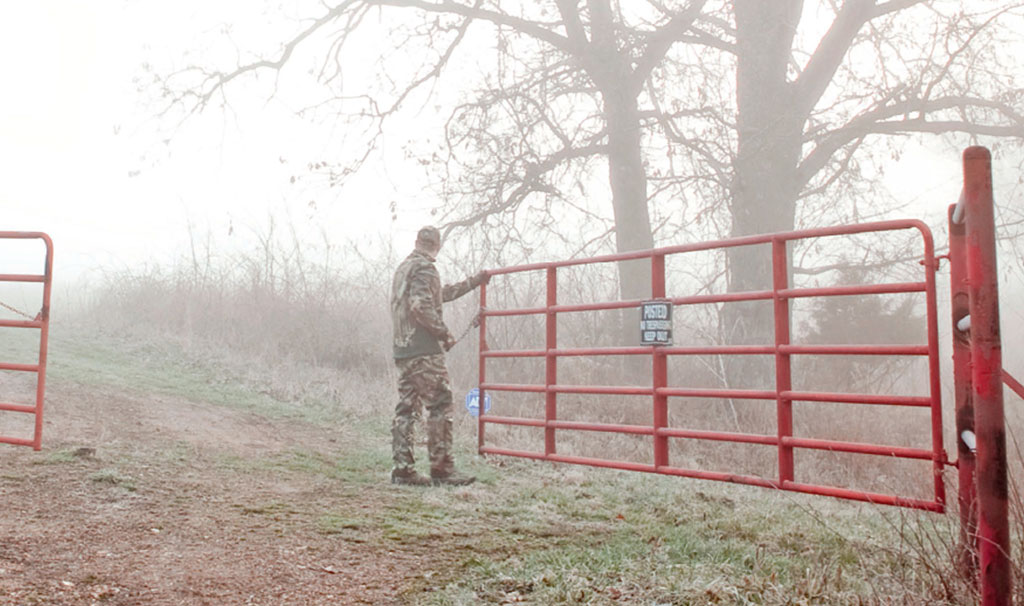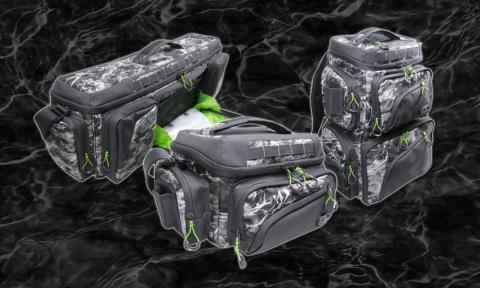Wes Delks
It was the morning of November 7th, the temperature was dropping and the first snow flurry of the year was forecasted for mid-morning. To say my expectations for deer movement were high would be an understatement!
I sat there, one, two, three, and then four hours and never even caught a flicker of a tail through the timber. I slowly climbed down from my perch, utterly dejected by the uneventful morning. I had intentionally left this spot unhunted for just the right time. As I walked back to the truck along the creek bottom, something caught my eye that made my heart sink; a scent dripper. A poacher was hunting my honey hole!
I’m sure many property managers can relate to the discouragement of having to police their own property from those who lack the respect for another’s boundary. Having a trespassing or poaching issue on a piece of property that one has worked so hard to properly manage, in my opinion, is one of the most discouraging and gut wrenching problems a gamekeeper can face. However, there are some things we can do to definitely diminish the likelihood of these unscrupulous thieves crossing your boundary.
If you already own property and fight trespassing battles, do your best to control access, create habitat edges on property boundaries, maintain relationships with adjacent landowners and when poacher interactions do happen, make certain they will not return to your property.

1. Control Admission
Putting a “No Trespassing” sign on every tree on the property border may be a bit excessive; however, at least no one can claim they didn’t see any signs. I like to put up “No Trespassing” signs so that even during full-foliage someone would still be able to clearly see a sign at all the possible places someone could enter the property. Corners of the property, creek crossings, and all normal property entrances should be clearly marked for the public.
Plastic signs should be attached to a board. Otherwise, if they’re put directly on trees or other imperfect surfaces, plastic signs only seem to last one season, maybe two. Metal signs are expensive in comparison, but they can last for decades. Some choose to use metal signs at their access points and corners and then fill in between them with plastic signs or home-made options.
Metal signs can be homemade out of thin sheet metal. They can be bought in precut sizes or you can cut your own from a roll. When cutting your own, if you use metal shears to cut thin sheet metal, it curls and can be difficult to flatten properly. Instead, score it with a heavy-duty utility knife and simply snap at the cut.
Then, wipe once with a simple damp cloth and once the metal has dried, wipe down again with white vinegar. The acid in the vinegar will act to score the metal and help the paint to adhere. Once the metal is dry, prime it using an exterior multipurpose latex primer, or a primer specifically for galvanized metal. Then use a “No Trespassing” stencil with a quality exterior latex paint for the lettering. Signs like this can be made for about ¼ the cost of professionally made signs. While they don’t look quite as nice as the professional signs, they are every bit as effective and legal.
Entrances to the property should be controlled with locks. This can be as simple as a cable connected to two trees with a padlock or as fancy as a remote controlled gate. Controlled entrances not only help protect against poachers but also add value to the property. A combination lock can be used if you wish to allow access to others.
At entrance lanes into the property the last thing you should want is a long, clear lane looking into the property from the road. If possible, I like for the access lane to curve into thicker habitat or have some sort of topography feature that limits visibility into the property. Long, straight, clear entrance lanes are easy places for poachers to shine lights into during the middle of the night. You want to hinder these types of opportunities as much as possible.
2. Hide the Temptation
Ideally, every boundary of a property should be a distinct habitat change or protected by screening cover. This may be a timber to road edge, native grasses to water, food plot to field edge, or a many other possibilities. The idea is that deer and people see a very distinct habitat difference when they cross any property border into my wildlife utopia.
Additionally, if I have any large open areas or food plots along property edges I screen these locations from roadside visibility with various types of plantings. Screening cover can be annual grasses like BioLogic Blind Spot, corn or millet, or more permanent solutions like perennial grasses or conifer trees.
A combination of trees, shrubs, and warm season perennial grasses often makes the best visual screen. It’s important to put some thought behind this because certain plants lose their foliage during various times of the year and as things grow they may elevate tall enough so they are no longer a visual barrier after a few years. So make sure that you consider both seasonally and for the long term.
3. Good Communication Skills
There is an old saying that “Good fences make good neighbors.” I believe there is a lot of truth to that. It is important for neighboring landowners to know where the property lines are and what your stances are on letting others have access. Be intentional about being a good neighbor. If a neighboring hunter wants to blood-trail a deer going into your property, think about how you would like to be treated if the situation was reversed.
Many times trespassing issues can be completely stopped if all neighboring landowners are on the same page. I have seen multiple times in areas with bad trespassing problems, a community of property owners working together can halt poachers. Landowners can share trail camera pictures of trespassers with each other and show evidence to law enforcement so repeat offenders are handled appropriately.
Along the same line of communicating with your neighbors is NOT communicating with others how your hunting has been. Everyone likes to brag about harvesting a nice buck or all the deer feeding in one of their food plots. Be careful who you boast in front of. Word of a huge buck travels fast and for some reason “antlers” can make normally principled people do stupid things.
4. That Dog Bites!
When you do have a face to face encounter with a trespasser or poacher, always use discernment and wisdom. No big buck sanctuary is ever worth losing your life over. With that being said, encounter trespassers with confidence. They are in the wrong and you have the right to make them very aware of that. By the end of your discussion with them, you should be confident that they will never return to your property.
You must prosecute blatant trespassing! Let it be known that there are consequences. Once the word gets out that trespassers will be charged, this should have a significant impact. Use trail camera photos of trespassers for evidence. In most states, to prosecute a trespasser all you need is a clear, identifiable photo of the trespasser in the act.
Law enforcement may or may not need to get involved every time. If I have a couple of teenagers hanging out, law enforcement may not be necessary. Oftentimes a good scare is all it takes. However, if someone is hunting on my property, the law will be notified. Others must know this will not be tolerated. Usually, once the word gets out that trespassers will be prosecuted, you’ll have fewer people who consider attempting it.
Whether it is looking for a new property or taking care of the property you have, with good property management we can reduce the likelihood of trespassers and better control access to the properties we love.
~
For more GameKeeper property management tips, read “A Property Access Plan is Money Well Spent!” As everyone knows, land comes with many variables – from creeks and rivers, to timberland, cropland and perhaps even underground waters or wetlands. It is imperative for a land manager to be able to access all areas of the property 365-days a year, which is why a plan must be put in place and executed to create access roads and crossings that will provide the ultimate safety necessary to work well with Mother Nature’s variables.




























